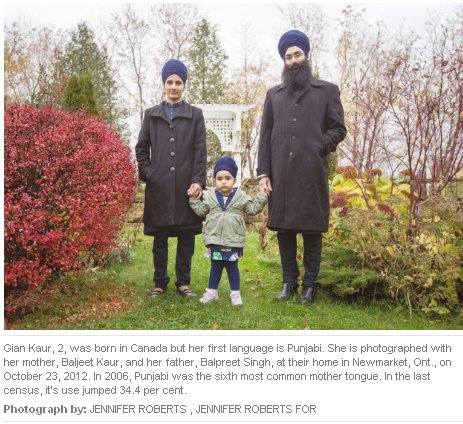
OTTAWA - Canada is steadily becoming a nation of many languages, as recent waves of immigration turn the country's main cities into a translator's paradise.
The trend was revealed in new data from the 2011 census released by Statistics Canada Wednesday, which reported on more than 200 languages now being used in the country.
It's far too soon to envision the demise of English or French as the country's two dominant languages, but the figures show a rise in other languages - primarily Asian - that people speak at home.
Walk into the living rooms or kitchens of many Canadian homes these days, and you'll increasingly hear people speaking Chinese dialects, Punjabi, Arabic, Persian, Spanish and Tagalog (a Philippine-based tongue that saw the biggest spike in use in recent years).
The census found that 6.6 million people (20 per cent of the population) said they spoke a language other than English or French at home.
Most of those (6.4 million) spoke an "immigrant" language, while 213,000 spoke an aboriginal language and 25,000 used sign language.
There were 2.1 million people who only spoke a language other than English or French at home, accounting for 6.5 per cent of the population.
By comparison, the census found 19.2 million people (58 per cent of the population) spoke only English at home, while six million spoke only French (18.2 per cent of the total.) In Quebec, where the protection of the French language is a politically explosive issue that has prompted controversial policies by the recently elected Parti Quebecois, new census figures are sure to catch the government's attention.
The proportion of Quebecers speaking only French at home continues to decline - from 77 per cent in 2001, to 75.1 per cent in 2006, and 72.8 per cent last year.
Meanwhile, the state of bilingualism in Canada is in doubt. The number of people who can conduct a conversation in both English and French jumped by nearly 350,000 to 5.8 million.
That meant the bilingualism rate of the Canadian population edged up from 17.4 per cent in 2006 to 17.5 per cent in 2011. But the hike is largely due to people in Quebec speaking both languages. Outside the province, the rate of bilingualism dipped slightly, by half a percentage point.
Statistics Canada said that despite the influx of immigrant languages, the country's two "official languages" remain dominant.
English and French "exert a strong pull as languages of convergence and integration into Canadian society, especially as languages of work, education and the provision of government services to the public," said the agency.
Indeed, the number of people speaking more than one language at home is increasing.
In 2011, 17.5 per cent of the population (5.8 million people) spoke at least two languages at home - compared to just under 4.5 million (14.2 per cent) in 2006.
Still, there is little doubt that new languages are changing Canada's cultural landscape, and demographic experts say that's a good thing.
"It really reflects the immigration patterns that we have seen evolve over the past two or three decades that shift away from the European immigration and toward Asia and Latin America," said Doug Norris, chief demographer at Environics Analytics.
"When I look at the globalized world that we live in, the fact that we ourselves are becoming more diverse and reflecting all of those languages is a real asset to us as a country today.
"I think it strengthens us as a nation as opposed to a country which was very singular in terms of its language or ethnicity."
However, Norris said the change has consequences. Canadian companies hoping to sell their products and services to immigrants must increasingly communicate and advertise in many new languages.
Similar challenges now apply to governments - from school boards that must deal with young students coming from immigrant families, to public health authorities that provide services to new immigrants.
Statistics revealed that nine in 10 Canadians who spoke an immigrant language most often at home lived in a city. The majority (80 per cent) lived in the country's six largest cities.
- In Toronto, 1.7 million people (32.4 per cent of the city's total population) spoke an immigrant language most often at home. Chinese languages and Punjabi are most common.
- In Montreal, 626,045 people (16.5 per cent of the population) spoke an immigrant language most often at home. Arabic, Spanish and Italian are most common.
- In Vancouver, 711,515 people (31 per cent of the population) spoke an immigrant language most often at home. Chinese and Punjabi are most common.
- In Calgary, 227,515 people (18.9 per cent of the population) spoke an immigrant language most often at home. Punjabi, Tagalog and Chinese are most common.
- In Edmonton, 165,145 people (14.5 per cent of the population) spoke an immigrant language most often at home. Tagalog, Punjabi and Chinese are most common.
- In Ottawa-Gatineau, 140,675 people (11.5 per cent of the population) spoke an immigrant language most often at home. Arabic, Chinese and Spanish are most common.
Twitter.com/Mark_Kennedy_
© Copyright (c) Postmedia News

